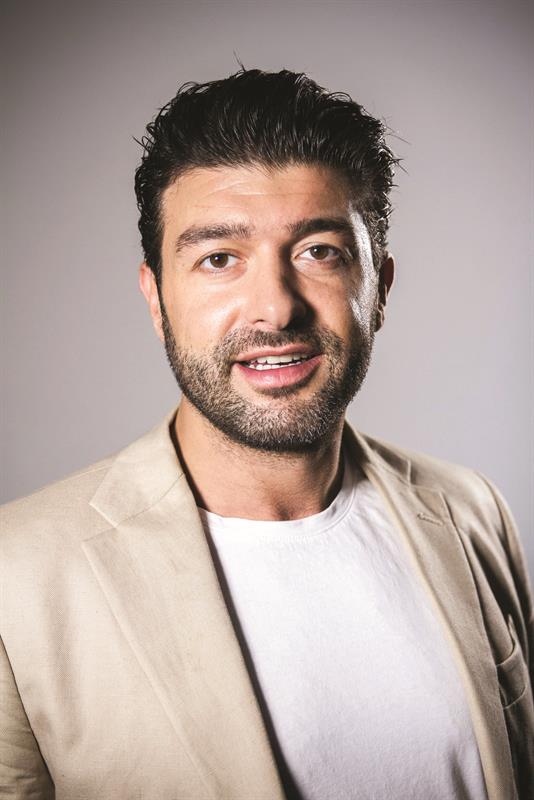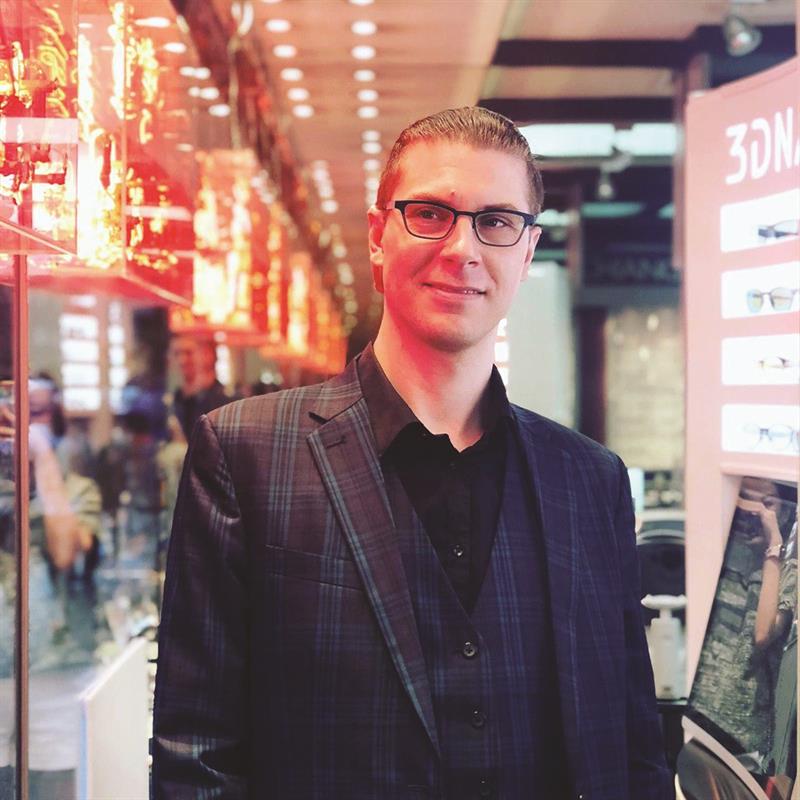
There is ‘amazing growth potential’ for 3D printing in the eyewear industry, according to Alireza Parandian, head of global business strategy at 3D printing and software company Materialise.
Materialise delivers 3D solutions across a number of industries and only chooses to work in a particular field if the technology can have a meaningful impact. ‘There is an increasing awareness around the capabilities of 3D technologies, which is going to increase the demand for it to be used in the eyewear industry,’ he shares.
 Alireza Parandian
Alireza Parandian
However, co-founder of 3DNA, Dennis Zelazowski, disagrees with Parandian’s forecast. In 2017, following four years of market research and testing, 3DNA abandoned 3D printing after concluding that there is a quality gap between 3D printed and traditional materials.
‘3D printing will never reach parity for quality, beauty and feeling that traditional materials offer,’ he says. However, 3DNA sees the future going digital, in terms of design and bespoke production. ‘Digital production is only a matter of time and we intend to be the platform that leads the way,’ Zelazowski adds.
While divided on 3D printing, they agree on the capabilities of 3D technologies and its potential to change the eyewear
industry.
Expectations vs reality
Parandian concedes that 3D printing will not work for everyone but explains that it will enable some companies to achieve what they previously have not been able to do. ‘People who have a significant background in eyewear design, highly talented people who have a vision about a product that could be made but could not be developed using conventional ways of manufacturing, they are now enabled by 3D printing and can offer something new to customers,’ he explains.
Among Materialise’s list of 3D eyewear partnerships is L’Amy where they have created titanium 3D designs for its McLaren brand. ‘In 2013, we set ourselves the goal to really educate designers, brands and even the management of the eyewear industry about these capabilities and how they could move from 2D design into 3D design,’ Parandian says, explaining that the more this happens, the more the market will grow.
Parandian explains that Materialise identified eyewear as an industry where 3D printing was capable of adding significant value. ‘That was important at that point in time, but we also understood that it was not going to happen overnight. We have seen an incredible level of uptake in the past seven years and we’re happy with that.’
Creating an experience
When asked if 3DNA had met its expectations for market share, Zelazowski says that the company set out to take and maintain a leading position in digital, bespoke design and partner with early adopters in the optician and eyewear market. ‘To that extent we have reached our target and continue to grow,’ he shares.
In terms of the response from optical practices, Zelazowski states that for the opticians who like to complain about being disrupted by online sellers, 3D technologies offer the opportunity to differentiate. ‘The leaders of the market see 3D technology as a weapon to wield in the battle for market share, not only to stay relevant, but to provide an eyewear buying experience that is highly differentiated from a mostly commoditised and homogenous competitive landscape,’ Zelazowski shares.
 Dennis Zelazowski
Dennis Zelazowski
He says that 3DNA has seen results in North America, Hong Kong, India and the UK, which he attributes to the skill and professionalism of the practitioners who are implementing and operating the 3D systems.
Parandian says that opticians are one of the most important stakeholders for Materialise in the eyewear industry. ‘They have been very demanding from day one. We have seen a massive pickup of the technology – 40-50% of industry growth every year. We owe that to the opticians who are educating themselves but also educating their end consumers, because they are doing a job in creating an understanding of what our technology has to offer,’ he explains.
Materialise received advice from Oliver Goldsmith who told the company about British design and how the UK eyewear industry works in order to help Materialise develop its products. ‘We have done significant work already to turn some of his great 20th century designs into 3D models and to print them with 21st century technology. He loves the concept, but more adoption of brands in the UK definitely requires new materials, which are not far off the horizon,’ he adds.
Opticians across Europe stock Materialise’s 3D printed products from independent brands it has worked with and its own Yuniku platform that was developed in partnership with Hoya. ‘A lot of UK opticians have adopted 3D printed products from brands such as Mykita, Gotti and Monoqool. However, they have been more conservative in adopting 3D printing technology.’
Parandian says that an optical practice is capable of offering a 3D experience in store by involving the customer at every stage. ‘People love the optician to navigate them through the choices and be involved in making the choice together. It’s a great tool for the optician in terms of creating that unique experience and allowing them to differentiate their own offering, eventually creating more loyalty to the services in store.’
Marketing gold
3DNA is currently building a vertically integrated eyewear platform, which includes a mobile app that enables consumers to scan their face at home and then connect with an optician. It is also developing a desktop frame edger to enable bespoke frame production to be done on-site, which Zelazowski says could add ‘tremendous value capabilities to opticians and labs.’
The 3DNA mobile app will be released in June, allowing consumers with iOS devices to connect to any optician that has a 3DNA kiosk for design sessions that can be conducted in real-time from home. Zelazowski explains that this provides practices with an accurate and viable platform to access online markets that they have previously been missing out on. ‘Opticians can contact their patient base and schedule design sessions or perform them on-the-fly. Opticians can earn income for performing the remote design sessions, which increases if the patient comes into the store for preselection or dispensing,’ he says.
The consumer plays an integral part in the eyewear design process, with their personality and preferences built into the product. Zelazowski says that involving customers in the design process so that they can create something of their own is ‘word-of-mouth marketing gold’ for practice.
The 3DNA scan is high resolution and precise, enabling the eyewear to be cut-to-fit so that the moulded bridge fits the nose contour perfectly and the bend behind the ears is cut directly into the material. Zelazowski explains that this reduces, and in most cases, eliminates the need for adjustment on non-adjustable materials such as wood, seashell, stone, cork, carbon-fibre and buffalo horn.
Guest designers will be added to the platform, who can earn commissions on their designs and any bespoke sessions they host, creating a new revenue stream. Materials from different suppliers are also being added, including over 1,500 Mazzucchelli acetates to the platform.
‘We have created a niche in the bespoke space that has enabled our partners to leverage our technology and cement their leading position in their communities. Creating a new shopping experience, whether in-store or via telemedicine,
continues to enhance this level of differentiation,’ Zelazowski adds.
Materialise is currently working on material technology combinations in 3D printing, as it evolves alongside engineering capabilities. Parandian says: ‘Materials is an area that is very important and we are collaborating with BASF to make materials that are more translucent and appealing to a larger audience in the eyewear industry. At the same time, we are working with manufacturers to improve the speed and reliability of the technologies.’
Parandian shares that sustainability is something that is still being worked on despite 3D printing already creating less waste than traditional methods. ‘We are more sustainable than conventional technologies, which are creating more waste and are not so tuned in to making products on a make-to-order basis, but that’s not the end of it for us’ he explains.
As 3D technologies become more widely adopted, Parandian says that it is important to focus on improving quality. ‘3D printing is not going to take craftsmanship out of the eyewear process. It is going to be a lot about interaction of very highly skilled people with 3D machines. Traditional processes of eyewear making require a lot of expertise and craftsmanship and 3D printing does as well. It’s very important to keep developing those necessary skills to be able to scale up fast, as the demand is growing for the technology. What I think will happen in the next five years is that you’re going to get a large variety of new materials that are going to enable an even faster adoption of 3D printing, as it’s going to allow more differentiation between the different players that are going to adopt it,’ he concludes.
